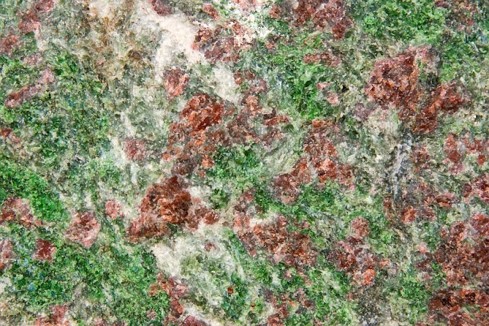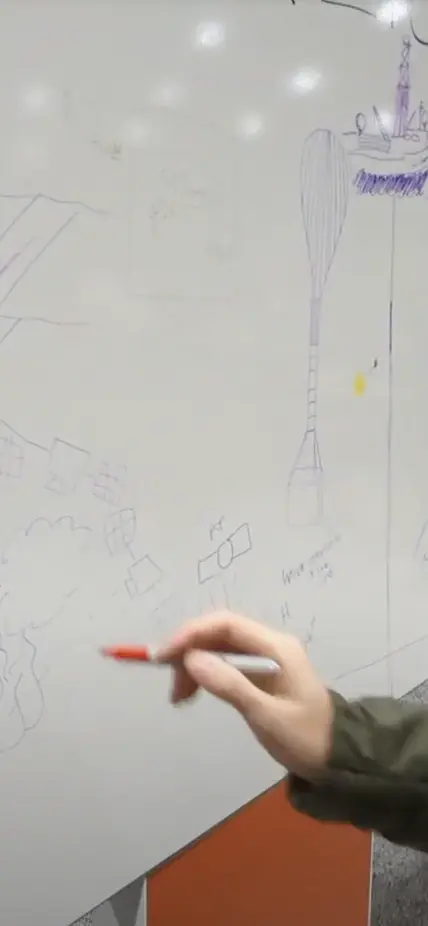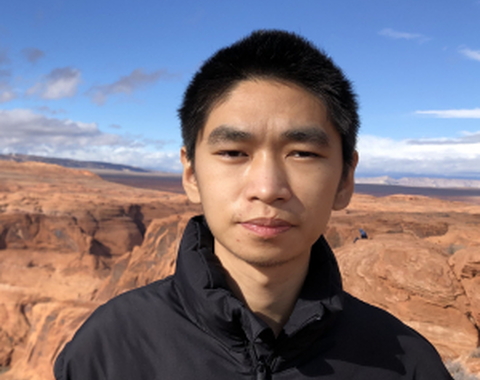Mineral physicist and Carnegie postdoc Ming Hao combines high-pressure physics with a sprinkling of seismology to uncover the secrets of our planet’s interior. At the 2022 American Geophysical Union Fall Meeting, Hao received the Mineral and Rock Physics Graduate Research Award for his graduate work on the seismic visibility of eclogite.
We stopped by to ask a few questions for this special edition postdoc spotlight, straight from the poster hall at AGU.
A little background
Because scientists can’t dig down into the mantle of our planet to study it firsthand, scientists rely heavily on seismology to see what’s happening inside of our planet. Much like an ultrasound helps doctors see inside of your body, seismic waves move through our planet at different rates depending on what material it’s moving through at any given time.
Seismologists can use these differences in the seismic velocity of our planet’s interior to map out these invisible structures that churn beneath our feet. This work allows us to better understand the hazards associated with geological events, like volcanoes and earthquakes, or even help us discover key material resources like gold or oil. At the same time, it uncovers the development and history of our planet—and planets in general.
In order to truly map out the inner workings of our planet, seismologists work with scientists like Hao, who use high-pressure and high-temperature laboratory experiments and Brillion spectroscopy to determine a material’s seismic velocity—the rate that a seismic wave moves through a material. By carefully studying the physical changes of materials under extreme conditions that they might experience inside of our planet, mineral physicists can figure out how to identify the material in seismic data
Hao focuses his research on a metamorphic rock eclogite, a material that forms as the basaltic oceanic crust is subducted into the Earth’s mantle. As it descends, the high pressures and temperatures squeeze and dehydrate the rocks until they turn into the metamorphic rock eclogite. The striking green and pink eclogite, dominated by the minerals omphacite and garnet, is extremely dense compared to “normal” mantle material—which consists primarily of pyroxene and olivine.
Trying to understand what happens to eclogite in the deep Earth raises a lot of questions:
- Does eclogite become so dense that it dives to the bottom of the mantle, dragging oceanic plates along with it and driving mantle convection?
- Is the dense eclogite the cause of the lower mantle’s mysterious large low-shear velocity provinces (LLSVPs)?
- Is the eclogite we find in the mantle subducted oceanic crust or is it delaminating and falling off the bottom of the continental crust?
These are just some of the questions scientists like Hao can begin to answer by studying the seismic velocity of mantle materials in the lab.
In order to truly map out the inner workings of our planet, scientists like Hao use high-pressure and high-temperature laboratory experiments and Brillion spectroscopy to determine a material’s seismic velocity—the rate that a seismic wave moves through a material. By carefully studying the physical changes of materials under extreme conditions that they might experience inside of our planet, mineral physicists can figure out how to identify the material in seismic data.
To reach such extreme conditions, Hao uses a diamond anvil cell to apply pressure on almost microscopically small samples of eclogitic minerals in the lab. The goal? To precisely determine the material’s seismic velocity under extreme conditions and help uncover the mysterious inner workings of the deep Earth.
Interview with Ming Hao
The interview below has been edited for length and clarity.
What’s your name, and what do you study?
Hi everyone, I’m Ming Hao; I’m a postdoc at the Carnegie Institution for Science working with Dr. Anne Pommier and Dr. Mike Walter. I just graduated half a year ago from the University of New Mexico with my Ph.D.
My field is specifically mineral physics but is more like the study of the Earth’s deep interior.
You recently won AGU’s Mineral and Rock Physics Graduate Research Award. What was the award for?
My award was primarily for my Ph.D. work studying seismic velocity measurements to help people identify eclogitic materials in the deep Earth. This is very important to understand how we bring those enriched materials into the deep interior.

Okay, so what is eclogite or eclogitic materials? What makes them special?
Eclogite is a metamorphic rock containing garnet and omphacite. Typically eclogites result from ultrahigh-pressure metamorphism of mafic rock (basalt). Different from the normal rocks in the field, which are brown, gray, or black, eclogites have remarkable green and red colors. As one of the most important driving forces for subduction, eclogites are important for us to understand subduction and mantle convection.
Why is this type of research important?
Basically, my goal is to try to identify eclogitic materials, which are a little different when compared to the normal mantle.
The normal mantle is mostly peridotite, but according to geochemical observations, we should have some enriched [eclogitic] reservoirs in the deep Earth that are totally different from the normal mantle.
Right now, the most powerful tool that we have to understand the deep Earth is seismology. We need to use seismic observations to help us to constrain the structure of the deep Earth. But, to do that, we need to know the seismic properties of these eclogitic materials so that we can find them and begin to understand how they got down to the deep Earth and what happened in their history.
Was it mantle convection? Or subduction? Or maybe delamination? We need to identify where those materials are and how they got there to find out.
That’s what my work is on.
We measure the sound velocity of eclogite in the lab to help those seismologists to constrain where the eclogites are and help build the story of what’s actually happening in the deep Earth.
What is the biggest challenge to doing this type of research?
The biggest challenge is sample preparation! For the Brillion measurements, we need to use very tiny samples that are about 20 microns thick—it’s very, very thin. And then you have to cut those samples to be very small in order to put those samples into the extremely high-pressure and high-temperature conditions that you need for the velocity experiments.
Even at very high-pressure conditions, we need the crystal itself to be in very good condition—transparent, no cleavage, no fractures—so we can get very good experimental signals. Sometimes you spend a lot of time just preparing the samples.
You know, with 20 microns, you may not even see it with your eyes! Working with these samples is kind of like having to draw a picture under a microscope.
What is the coolest thing about your research?
The coolest thing is that you can use two diamonds to compress the sample to achieve extremely high pressures that are exactly the same as the Earth’s deep interior hundreds of kilometers deep. It’s really really cool!
How did you get into this field?
That's a good question! When I was in high school, I started learning about the inside of our planet and its different layers—crust, mantle, and core. It was really amazing to me because in our daily life, we kind of thought, “Okay, Earth is a sphere. There are some mountains, there are some seas.” But I didn’t really know about the deep interior and how there are a lot of structures inside of our planet that are really amazing!
So, I wanted to know what's really happening in the deep Earth—what it truly looks like.
After high school, I chose to major in geology and get my Ph.D. in mineral physics and a high-pressure field so I could really look at what we cannot see in our daily life.
Do you have any advice for students looking to make the most out of their graduate school experience?
My advice is to find mentors like my former advisor Dr. Jin Zhang, who really helped me a lot during my Ph.D. work and who nominated me for my graduate award.
Even though I had already done some high-pressure work when I was an undergraduate, I did not have any Master’s experience. Because I went directly from my undergraduate studies to my Ph.D., Dr. Zhang really helped me to become a good Ph.D. student. She honed my experimental skills, provided the background and process for trying to understand what is happening inside the Earth as a whole, and taught me what questions to ask. Which parts do we need to focus on? Which method we can solve the problem with?
I really appreciate all of the help I got from Dr. Zhang.
This type of mentorship is important because undergrads learn all sorts of different things from across the spectrum of geosciences—volcanology, seismology, mineralogy, et cetera. We build up all of these basic, separate skills.
A mentor helps you pull all of that together, so you can begin to truly understand what the processes look like inside of the Earth.
I think that's a very important part of the Ph.D.—gradually you’re building an understanding of the entire process and learning what problems to solve and how to combine different methods to solve them.
What projects are you working on now?
Right now, we are mostly working on mantle wedge reactions. Different from my previous work which focused only on the subducted slab itself, the new work moves further to the reactions between the slab and the normal mantle.
Subduction is very important for geoscience. When material subducts down to the mantle, because of the high pressure and high temperatures, the hydrous layer will be melted, and then some melt or magma will go to the mantle and react with it.
Now, my postdoc is focusing on this specific part of the process—the reaction from the subduction zone to the normal mantle. We want to have some idea of both the seismic velocities and electrical conductivities for those reactions in the wet parts of the mantle.
What’s next for your research?
We are still looking at what’s really happening in these wet parts! When we have a better idea of what the minerals look like and what the melts look like, we can do multi-anvil experiments to generate similar P-T conditions to measure the sound velocity and the electrical resistivity. Then we can compare it to real-world observations, and truly understand what has happened in these areas!
It sounds like you’re constantly combining seismology with mineral physics. Do you think collaboration is important for this work?
I like to have access to different types of scientists to discuss problems with and to get new ideas from different fields. I may be working in mineral physics, but we need to borrow observations from seismology all the time!
It’s really important to know what they think, how they understand the earth, and how they understand our experiments. Having that combination is really cool.

